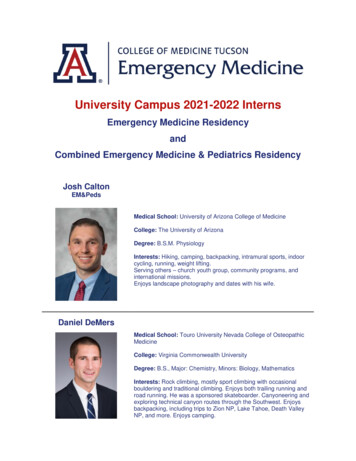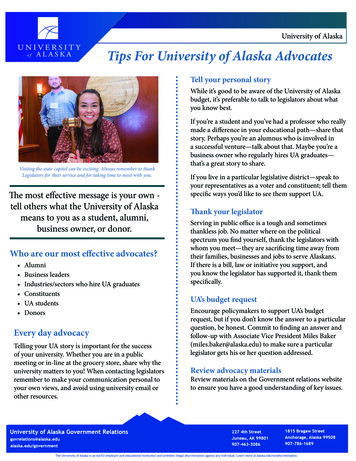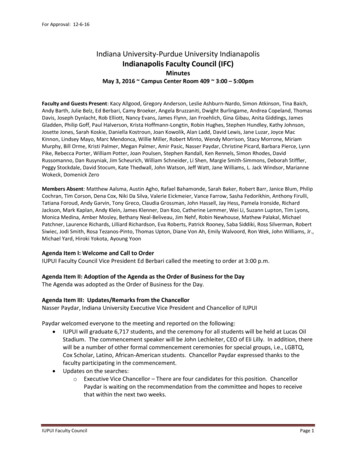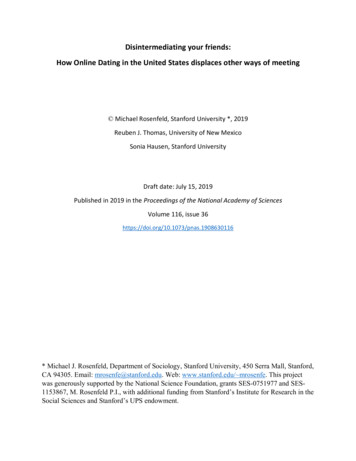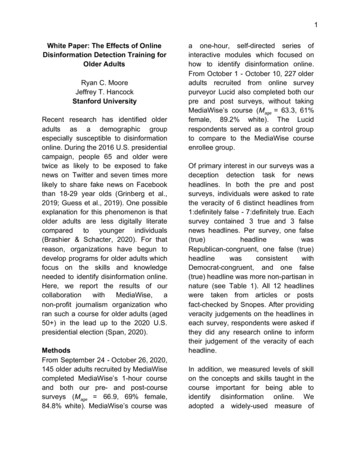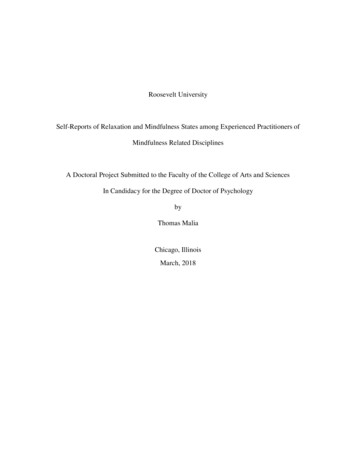
Transcription
Roosevelt UniversitySelf-Reports of Relaxation and Mindfulness States among Experienced Practitioners ofMindfulness Related DisciplinesA Doctoral Project Submitted to the Faculty of the College of Arts and SciencesIn Candidacy for the Degree of Doctor of PsychologybyThomas MaliaChicago, IllinoisMarch, 2018
ProQuest Number: 10752124 All rights reserved INFORMATION TO ALL USERSThe quality of this reproduction is dependent upon the quality of the copy submitted.In the unlikely event that the author did not send a complete manuscriptand there are missing pages, these will be noted. Also, if material had to be removed,a note will indicate the deletion. ProQuest 10752124Published by ProQuest LLC (2018 ). Copyright of the Dissertation is held by the Author. All rights reserved.This work is protected against unauthorized copying under Title 17, United States CodeMicroform Edition ProQuest LLC. ProQuest LLC.789 East Eisenhower ParkwayP.O. Box 1346Ann Arbor, MI 48106 - 1346
AbstractIn recent years psychology has devoted considerable attention to the Buddhist concept andpractice of mindfulness. However, there continues to be disagreement as to how to definemindfulness, and many competing definitions and measures of mindfulness are available. TheR/M Tracker is one self-report measure used to define and assess experiences that individualshave while practicing mindfulness. The present study was conducted in two parts. First, theunderlying factor structure of the R/M Tracker was examined. Second, we examined therelationship between age, gender, the total number of months practicing mindfulness, presentsession duration, length of average session, recalled regularity of practice in the past month,recalled recent regularity of individual practice (past week), recalled recent regularity of grouppractice (past week), and times practiced per day. Six factors were identified by means of aprincipal components analysis (PCA) on the R/M Tracker: Mindful Transcendence, MindfulFocus, Mindful Positive Emotion, Basic Mindful Relaxation, Pleasant Fantasy, and UnbotheredObserver. Results from multiple regression equations indicated that frequency of individualpractice in the past week significantly predicted an individual’s score on the MindfulTranscendence and Mindful Positive Emotion factors. Session duration had a significant negativerelationship with Mindful Transcendence.ii
Date of Oral Defense: March 19, 2018Doctoral Project Committee ChairName: Jonathan C. Smith, PhDPosition: Professor, Department of PsychologyInstitution: Roosevelt UniversityCommittee MembersName: Susan Torres-Harding, PhDPosition: Professor, Department of Psychology; Director of PsyD Program, College of Arts andSciencesInstitution: Roosevelt UniversityName: Michael Helford, PhDPosition: Associate Professor, Department of PsychologyInstitution: Roosevelt Universityiii
AcknowledgementsFirst and foremost, I would like to express my appreciation to Dr. Jonathan C. Smith forserving as my dissertation chair. Without his guidance, insight, and encouragement I might nothave completed this project. I would also like to thank Dr. Susan Torres-Harding and Dr.Michael Helford for serving on my dissertation committee. I am grateful for all of the support,guidance, and encouragement that you have given me in helping to complete this project and inmy personal and professional development throughout my time in the PsyD program atRoosevelt University.Next, I would like to convey my immense gratitude to my parents. Your unconditionallove and support in so many aspects of my life – academic, professional, and personal – havebeen essential in helping me to complete this project. Without your unwavering belief in myability to succeed in this program and in this profession, I would not be where I am today. Iwould also like to thank my sister for inspiring me to enter this field and find my calling in life.Your strength, perseverance, and compassion are an inspiration to me.Finally, I would like to express my utmost appreciation to my wife. You have been therefor me in more ways than I can count throughout this project and our lives together. You werethere to encourage and support me through stressful times and share genuine joy and excitementwith me during times of success. Without your boundless love, compassion, and support I wouldnot have completed this project.iv
Table of ContentsABSTRACT . iiACKNOWLEDGEMENTS . ivLIST OF TABLES . viiiLIST OF APPENDICES . ixCHAPTER I: INTRODUCTION . 1CHAPTER II: LITERATURE REVIEW . 2Definitions of Mindfulness . 2Classical Historical Definitions of Mindfulness . 3Western Psychological Conceptualizations of Mindfulness . 6First, Second, and Third-Generation Mindfulness . 7First generation mindfulness. . 7Second generation mindfulness. . 11Third generation mindfulness. . 12Western mindfulness in practice. . 19Assessment of Mindfulness . 19Kentucky Inventory of Mindfulness Skills (KIMS). . 20Mindful Attention Awareness Scale (MAAS). . 20Freiburg Mindfulness Inventory (FRI). . 21Cognitive and Affective Mindfulness Scale – Revised (CMS-R). . 21Southampton Mindfulness Questionnaire (SMQ). . 21The Five Facet Mindfulness Questionnaire (FFMQ). 22Toronto Mindfulness Scale (TMS). . 23v
Philadelphia Mindfulness Scale (PHLMS). . 24Implications for the Assessment of Mindfulness . 24The R/M Tracker Approach . 25Hypotheses . 26CHAPTER III: METHODOLOGY . 28Measures . 28R/M Tracker. . 28R/M Practice Scale. 29R/M Tracker Archival Data Pool . 29Participants. 30Hypotheses . 31Principal components analysis . 31Multiple Regression . 32CHAPTER IV: RESULTS . 33Factor Analysis . 33Factor 1: Mindful Transcendence. . 34Factor 2: Mindful Focus. 37Factor 3: Mindful Positive Emotion. . 37Factor 4: Basic Mindful Relaxation. . 37Factor 5: Pleasant Fantasy. . 37Factor 6: Unbothered Observer. . 38Multiple Regressions . 38Mindful Transcendence. . 39vi
Mindful Focus. . 40Mindful Positive Emotion. . 41Basic Mindful Relaxation. . 42Pleasant Fantasy. . 43Unbothered Observer. . 44CHAPTER V: DISCUSSION . 45Limitations. . 50REFERENCES . 52vii
List of TablesTable 1: R/M States and the Five Levels of Mindfulness and Relaxation17Table 2: Principal Components Analysis Total Variance Explained34Table 3: Summary of descriptive statistics for R/M Practice and R/M Tracker items35Table 4: Rotated Component Matrix for Principle Components Analysis Item Loadings36Table 5: Summary of multiple regression equation for Factor 1: Mindful39TranscendenceTable 6: Summary of multiple regression equation for Factor 2: Mindful Focus40Table 7: Summary of multiple regression equation for Factor 3: Mindful Positive41EmotionTable 8: Summary of multiple regression equation for Factor 4: Mindful Basic42RelaxationTable 9: Summary of multiple regression equation for Factor 5: Pleasant Fantasy43Table 10: Summary of multiple regression equation for Factor 6: Unbothered Quiet44viii
List of AppendicesAppendix A: The R/M Tracker Questionnaire61Appendix B: The R/M Indicators Questionnaire62Appendix C: The R/M Frequency Questionnaire63Appendix D: The R/M Practice Questionnaire64Appendix E: Manuscript to be Submitted for Publication65ix
1Chapter I: IntroductionMindfulness has grown in popularity in the field of psychology over the past 30 years(Bishop et al., 2004). During this time, many different mindfulness-based therapeutic andpersonal improvement interventions have been developed. Popular treatments includeMindfulness Based Stress Reduction (MBSR; Kabat-Zinn, 1982) initially applied to chronicpain, Mindfulness-Based Cognitive Therapy (MBCT; Teasdale et al., 2000) initially applied todepression, Dialectical Behavior Therapy (DBT, Linehan, 1991) for Borderline PersonalityDisorder, and Acceptance and Commitment Therapy (ACT; Hayes, 2008). Each of theseinterventions has spawned a substantial body of research (Brown, Marquiss, & Guiffrida, 2013).In addition, substantial research has examined the potential benefits of mindful practicein a nonclinical context. Mindfulness appears to improve attention and awareness of internalexperiences (Josefsson & Broberg, 2011; Semple, Lee, Rosa, & Miller, 2010), episodic andworking memory (Brown, Goodman, Ryan, & Analayo, 2016), compassion (Bankard, 2015),perspective-taking and empathy (Leppma & Young, 2016), and self-compassion, self-esteem,and self-acceptance (Thompson & Waltz, 2008; Weibel, McClintock, & Anderson, 2016).Additional research has identified specific brain changes that may occur in those who practicemindfulness (Lutz, Jha, Dunne, & Saron, 2015)Despite considerable research on the efficacy of mindfulness, there remains significantdisagreement in how mindfulness should be defined (Bishop et al., 2004). Partly as a result,current methods of assessing mindfulness are often incomplete or lacking in validity (Grossman,2011). The R/M Tracker was designed to address many of these assessment issues using thenatural language of practitioners (Smith, 2017).
2For the present study, I will examine the relationship between the amount of mindfulnesspractice, frequency of practice, reported length of average practice session, and demographicvariables and the experiences that individuals report when engaged in a mindfulness meditationexercise. First, I will present definitions for mindfulness from classical religious sources as wellas from more contemporary psychological sources. I will then compare how westernpsychological definitions of mindfulness vary from classical definitions and how they havechanged over time. Next, I will discuss a third generation definition of mindfulness which isbased on the natural language of practitioners of mindfulness. I will then review commonly usedpsychological measures of mindfulness that are currently available and describe the R/MTracker. Finally, I will describe the rationale for the present study. I predicted that individualswith greater levels of experience practicing mindfulness will report on the R/M Tracker higherlevels of mindfulness-related states of Mindful Awakening, Mindful Deepening, MindfulTranscendence, and Mindful Positive Emotion.Chapter II: Literature ReviewDefinitions of MindfulnessSmith (2017) defines meditation as an exercise and type of focus in which one quietlyrestricts and sustains attention on a limited target or stimulus. One can apply this attentionalstance to body sensations, one’s breath, a repeating word or mantra, or even yoga stretches andpostures. For mindfulness, one’s focus is generally broad, perhaps including the flow of soundsor all stimuli. However, for all meditation one’s attention is directed, extraneous mind-wanderingand distraction are gently put aside and one returns to ones chosen focus. However, preceding
3Smith’s definition is a rich history of often competing definitions and conceptualizations,including those from classical traditions and contemporary Western psychological scholarship.Classical Historical Definitions of MindfulnessMindfulness originated in Buddhism around 2,500 years ago (Brown, Creswell, & Ryan,2015). In this tradition, mindfulness is one path to enlightenment. To be enlightened is totranscend personal and subjective distortions and understand the true nature of reality (Kudesia& Nyima, 2015). When an individual attains enlightenment, they will be able to eliminate thesources of suffering in their life. Key to enlightenment is the realization of what Buddhisttraditions refer to as the Four Noble Truths (Gethin, 2011). The first noble truth is that life isfilled with suffering and dissatisfaction (“Four Noble Truths,” n.d.). The second noble truth isthat this dissatisfaction arises because people will cling to beliefs that do not match reality inorder to avoid further suffering. The third noble truth is that suffering and dissatisfaction endwhen an individual lets go of cravings for beliefs and expectations that do not match with reality,and instead embraces thoughts and actions that are in line with reality. Finally, the fourth nobletruth is that an individual can learn to let go of cravings and become free from suffering throughthe Noble Eightfold Path.The Noble Eightfold Path consists of right speech, right action, right livelihood, righteffort, right mindfulness, right concentration, right view, and right intention (“Eightfold Path,”n.d.). In Buddhist beliefs, following the Noble Eightfold Path to develop moral conduct,concentration, and wisdom will lead to enlightenment and the cessation of suffering (Kudesia &Nyima, 2015).Buddhist traditions present many practices claimed to foster growth in these three areas(Brown, Creswell, & Ryan, 2015). Broadly speaking, moral restraint is cultivated through
4adherence to monastic rules outlined in Buddhist texts, while the other two goals ofconcentration and insight are fostered largely through the practice of meditation. Thesemeditation practices generally fall within one of two categories – calm meditation and insightmeditation. Calm meditation involves focusing one’s attention on a simple object, such as amantra, an image, or one’s own breath in order to cultivate a deep concentration and calm mindthat results from being absorbed in thoughts of such simple objects. Insight meditation involvesquietly attending to thoughts and objects that are both part of ourselves and part of the externalworld. These objects of focus may include physical sensations, feelings, perceptions, urges, andour own consciousness. Central to insight meditation is viewing these phenomena, as well asone’s sense of “self” as an independent choosing agent, as temporary or impermanent,unsatisfying, and ultimately illusory. Indeed, this is a large part of the “insight” of insightmeditationWithin Buddhist traditions, mindfulness practices serve an important role in helping oneto achieve enlightenment (Brown, Creswell, & Ryan, 2015). Mindfulness helps the practitionerto direct attention to particular objects, thoughts, or experiences and to identify experiences asbeing impermanent, unsatisfactory, and not of one’s self. In this way, mindfulness is viewed as ameans of reducing suffering from thinking of experiences as being permanent or from thedevelopment of an individual ego (Chiesa, 2013).Mindfulness is commonly identified as a kind of insight meditation in both psychologicaland Buddhist writings (Brown, Creswell, & Ryan, 2015). However, this characterization may notbe entirely accurate, as many early Buddhist texts describe mindful practices as beinginextricably linked with cultivation of concentration and a calm mind. In these early writings, theauthors describe how the cultivation of concentration and focus leads to greater mindfulness, and
5how greater mindfulness also leads to increased capacity for concentration and having a calmmind. Thus, these practices do not oppose o
my personal and professional development throughout my time in the PsyD program at Roosevelt University. Next, I would like to convey my immense gratitude to my parents. Your unconditional love and support in so many aspects of my life – academic, professional, and personal – have been essential in helping me to complete this project.




